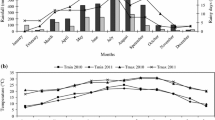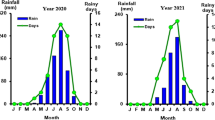Abstract
A study was conducted in Lilongwe and Dowa districts of central Malawi to assess the performance and productivity of pigeon pea (PP), cowpea (CP) and maize (MZ) when grown as sole crops, legume–legume and legume–cereal intercrops. The experiment was arranged in a randomized complete block design (RCBD). Analysis of variance for yields was carried out on a per plant basis and the productivity was assessed by using various competition indices including the land equivalent ratio (LER), relative dry matter yield (RDY), relative nutrient yields and the monetary advantage index (MAI). Results showed significantly higher (P < 0.05) grain yield per plant for the sole cropped PP and CP than their intercrops, but only slight differences were observed for MZ, at both study sites. However, for overall productivity, results showed higher productivity in terms of yields (LER > 1) and monetary gains (positive MAI values) in all the intercropping systems than sole cropping, at both study sites. Furthermore, the PP + MZ intercrop was the most productive system in terms of yields and monetary gains as it produced the highest LER and MAI values. From this study it is noted that prudent implementation of legume-based diversified intercropping systems including pigeon pea–cowpea and pigeon pea–maize intercrops can play a crucial role in sustaining the intensification of agriculture in smallholder dominated systems.



Similar content being viewed by others
Abbreviations
- ICRISAT:
-
International Crop Research Institute for Semi-Arid Tropics
- USDA:
-
United States Department of Agriculture
- WRB:
-
World Reference Base
References
Abd El-Lateef EM, Abd El-Salam MS, El-Habbasha SF, Ahmed MA (2015) Effect of maize–cowpea intercropping on light interception, yield and land use efficiency. Internat J Chem Tech Res 8(6):556–564
Auction Holdings Commodity Exchange (AHCX) (2014) Sales statistics for commodities in the 2013/14 marketing season. The Daily Times, August 11, p 18
Campos-M M, Campos-C R (2017) Applications of quartering method in soils and foods. Int J Eng Res Appl 7(1):35–39
Chilimba ADC (2007) Methods of soils, plants, fertilizers and miscellaneous analyses: a working manual for Chitedze and Bvumbwe Research Stations Soils Laboratories. Ministry of Agriculture, Lilongwe, Malawi
Chilimba ADC, Young SD, Black CR, Rogerson KB, Ander EL, Watts MJ, Lammel J, Broadly MR (2011) Maize grain and soil surveys reveal suboptimal dietary selenium intake is widespread in Malawi. Sci Rep 1:72. https://doi.org/10.1038/srep00072
Dhima KVA, Ruthourgidis AA, Vasilakoglou IB, Dordas CA (2007) Competition indices of common vetch and cereal intercrops in two seeding ratio. Field Crop Res 100:249–246. https://doi.org/10.1016/j.fcr.2006.07.008
Drinkwater LE, Wagoner P, Sarrantonio M (1998) Legume based cropping systems have reduced carbon and nitrogen losses. Nature 396:262–264
Edje OT (2014) Effects of intercropping maize (Zea mays L.) with pigeon pea (Cajanus cajan L.) on seed yield, litter and fuel wood in Mildveld Swaziland. Afr J Agr Sci Technol 1(2):1–8
Gerlach RW, Dobb DE, Raab GA, Nocerino JM (2002) Gy sampling theory in environmental studies. 1. Assessing soil splitting protocols. J Chemometrics J Chemometrics Soc 16(7):321–328
Ghosh PK, Tripathi AK, Bandyopadhayay KK, Manna MC (2009) Assessment of nutrient competition and nutrient requirement in soybean sorghum intercropping system. Europ J Agron 31:43–50. https://doi.org/10.1016/j.eja.2009.03.002
International Crops Research Institute for Semi-Arid Tropics/Ministry of Agriculture and Irrigation (2000) Cost-effective soil fertility options for smallholder farmers in Malawi. Bulawayo, ICRISAT; Zimbabwe and MAI, Lilongwe
Ishikawa S, Adu-Gyamfi JJ, Nakamura T, Yoshihara T, Watanabe T, Wagatsuma T (2002) Genotypic variability in phosphorus solubilizing activity of root exudates by pigeon pea grown in low-nutrient environments. Plant Soil 245:71–81
Kamanga BCG (2002) Farmer experimentation to access the potential of legumes in maize-based cropping systems in Malawi. Risk Management Working Paper 02-02. CIMMYT, Mexico
Kanyama-Phiri GY, Snapp S, Kamanga B, Wellard K (2000) Towards integrated soil fertility management in Malawi: Incorporating participatory approaches in agricultural research. Working Paper Managing Africa Soils No.11. Russel Press, London, UK
Kerr RB, Snapp S, Chirwa M, Shumba L, Msachi R (2007) Participatory research on legume diversification with Malawian smallholder farmers for improved human nutrition and soil fertility. Expl Agric 43:437–453. https://doi.org/10.1017/S0014479707005339
Landon JR (ed) (1991) Booker tropical soil manual. A handbook for soil survey and agricultural land evaluation in the tropics and subtropics. Wiley, New York
Legwaila GM, Marokane TK, Mojeremane W (2012) Effect of intercropping on the performance of maize and cowpea in Botswana. Int J Agric Forest 2(6):307–310
Maposa Y, Jideani VA (2017) The role of legumes in human nutrition. Intech. https://doi.org/10.5772/intechopen.69127
Mathews C, Jones RB, Saxena KB (2001) Maize and pigeon pea intercropping in Mpumalanga, South Africa. International Chickpea and Pigeon pea Newsletter 8. http://oar.icrisat.org/id/eprint/4895
Mhango WG (2011) Nitrogen budgets in legume based cropping systems in Northern Malawi. PhD Thesis. Michigan State University. East Lancing; USA
Mhango WG, Snapp S, Kanyama-Phiri GY (2017) Biological nitrogen fixation and yield of pigeonpea and groundnut: quantifying response on smallholder farms in northern Malawi. Afr J Agric Res 12(16):1385–1394
Mhango WG, Snapp SS, Phiri GYK (2012) Opportunities and constraints to legume production on smallholder farms in Malawi. Ren Agric Food Syst 28:234–244. https://doi.org/10.1017/S1742170512000178
Ministry of Agriculture and Food Security (MoAFS) (2012) Guide to agricultural production and natural resource management in Malawi. Agricultural Communications Branch. Lilongwe, Malawi, pp 132–152
Ministry of Agriculture, Irrigation and Water Development (MoAIWD) (2014) Minimum farm gate prices for strategic crops for the 2014/15 agricultural season. The Nation, Tuesday, May 11, p 19
Mloza-Banda R (1994) Principles and practices of crop management: field study guide. Crop Science Department, Bunda College of Agriculture, Lilongwe, pp 101–114
Mrema JC, Gumbe LO, Chepete HJ, Agullo JO (2011) Grain crop drying, handling and storage. Rural Structures in the Tropics: Design and Development, pp 363–386
Mutegi J, Kabambe V, Zingore S, Harawa R Wairegi L (2015) The fertilizer recommendation issues in malawi: gaps, challenges, opportunities and guidelines. Soil Health Consortium of Malawi, pp 7–42
Njira KOW, Nalivata PC, Kanyama-Phiri GY, Lowole MW (2012) Biological nitrogen fixation in sole and doubled-up legume cropping systems on the sandy soils of Kasungu, Central Malawi. J Soil Sci Environ Manag 3(9):224–230
Njira KOW, Semu E, Mrema JP, Nalivata PC (2017) Biological nitrogen fixation by pigeon pea and cowpea in the “doubled-up” and other cropping systems on the Luvisols of Central Malawi. Afr J Agric Res 12(15):1341–1352. https://doi.org/10.5897/AJAR2017.12167
Njira KOW, Semu E, Mrema JP, Nalivata PC (2020) Integrated soil fertility management based on pigeon pea and cowpea cropping systems influences nitrogen use efficiency, yields and quality of subsequent maize on Alfisols in Central Malawi. In: Singh B, Safalaoh A, Amuri N, Eik L, Sitaula B, Lal R (eds) Climate impacts on agricultural and natural resource sustainability in Africa. Springer, Berlin. https://doi.org/10.1007/978-3-030-37537-9_5
Phiri AT, Mhango WG, Njoloma JP, Kanyama-Phiri GY, Lowole MW (2012) Farmers evaluation of integrated soil fertility management methods in Northern Kasungu, Central Malawi. J Agric Ext Rural Dev 4(11):340–346
Ricker-Gilbert J, Jumbe C, Chamberlin J (2014) How does population density influence agricultural intensification? Evidence from Malawi. Food Policy 48:114–128
Saudy HS, El-Bagoury KF (2014) Quixotic coupling between irrigation system and maize–cowpea intercropping for weed suppression and water preservation. Afr Crop Sci J 22(2):97–108
Subbarao GV, Ae N, Otani T (1997) Genotypic variation in iron- and aluminium-phosphate solubilizing activity of pigeon pea exudates under P-deficient conditions. Soil Sci Plant Nutr 43(2):295–305
Tofinga MP (1993) Design and analysis of mixed cropping experiments for indigenous Pacific Island agroforestry. USDA Forest Service General Technical Report PSW-GR-140
Willey RW, Osiru DSO (1972) Studies on mixtures of maize and beans (Phaseolous vulgaris, L.) with particular reference to plant population. JAgric Sci 79:517–529
Yilmaz S, Atak M, Erayman M (2008) Identification of advantages of maize-legume intercropping over solitary cropping through competition indices in Eastern Mediterranean region. Turk J Agric For 32:111–119
Acknowledgements
The authors are grateful to the Alliance for Green Revolution in Africa (AGRA) for fully funding this study and Sokoine University of Agriculture (Tanzania) for coordinating the grant from AGRA. A farmer, Yohane Ngomacheza, from Dowa district (Malawi) and the Lilongwe University of Agriculture and Natural Resources (Malawi) are thanked for providing land for the research activities.
Author information
Authors and Affiliations
Corresponding author
Ethics declarations
Conflict of interest
The authors declare that they have no conflict of interest.
Additional information
Publisher's Note
Springer Nature remains neutral with regard to jurisdictional claims in published maps and institutional affiliations.
Rights and permissions
About this article
Cite this article
Njira, K.O.W., Semu, E., Mrema, J.P. et al. Productivity of pigeon pea, cowpea and maize under sole cropping, legume–legume and legume–cereal intercrops on Alfisols in Central Malawi. Agroforest Syst 95, 279–291 (2021). https://doi.org/10.1007/s10457-020-00589-0
Received:
Accepted:
Published:
Issue Date:
DOI: https://doi.org/10.1007/s10457-020-00589-0




